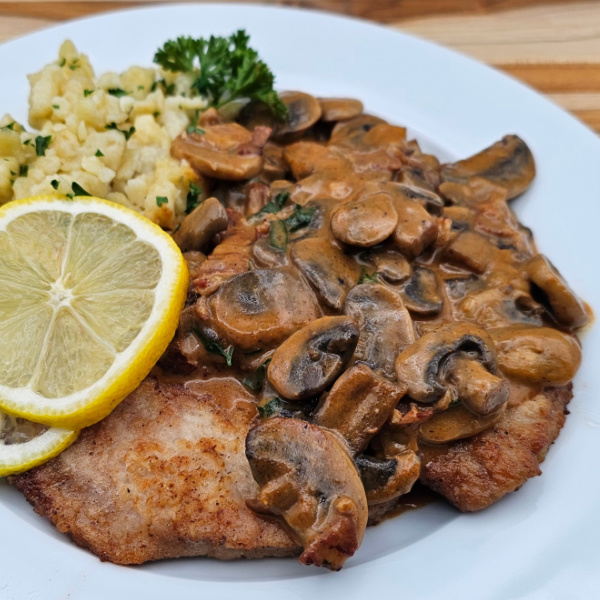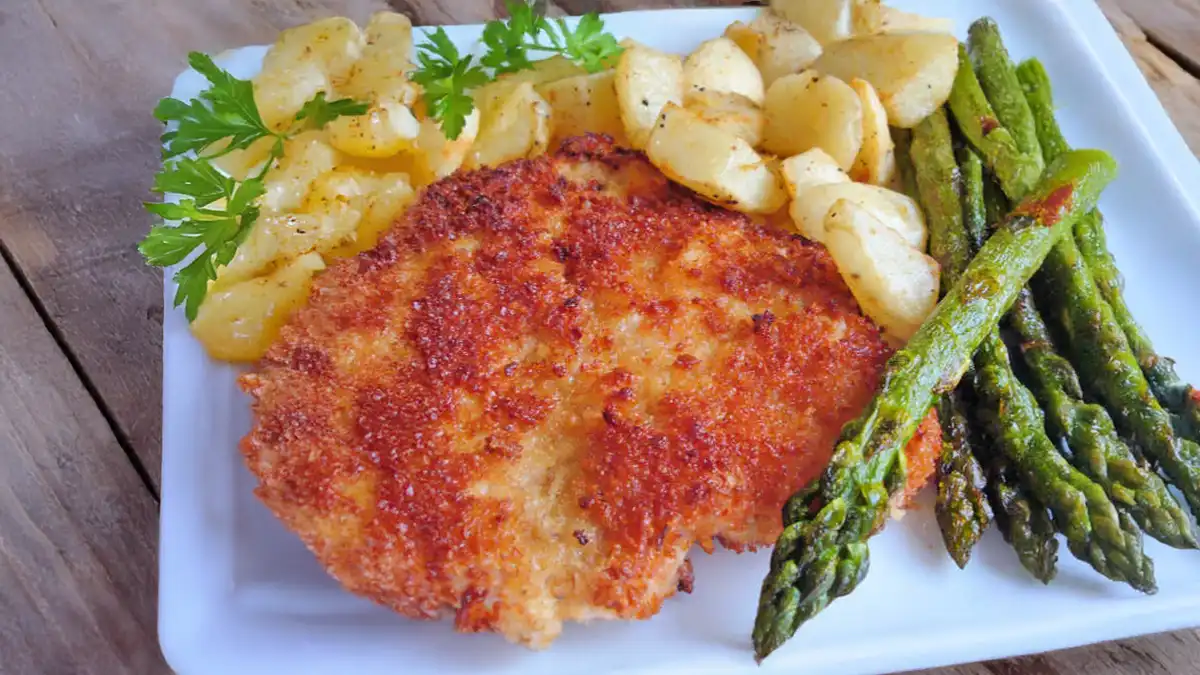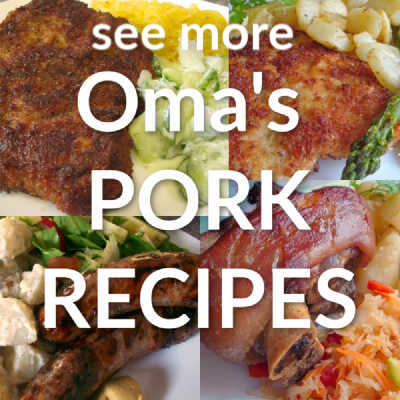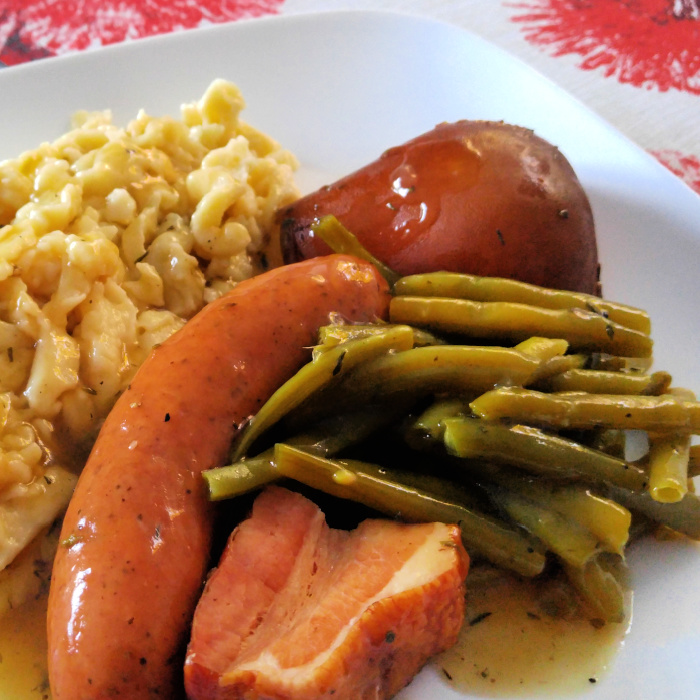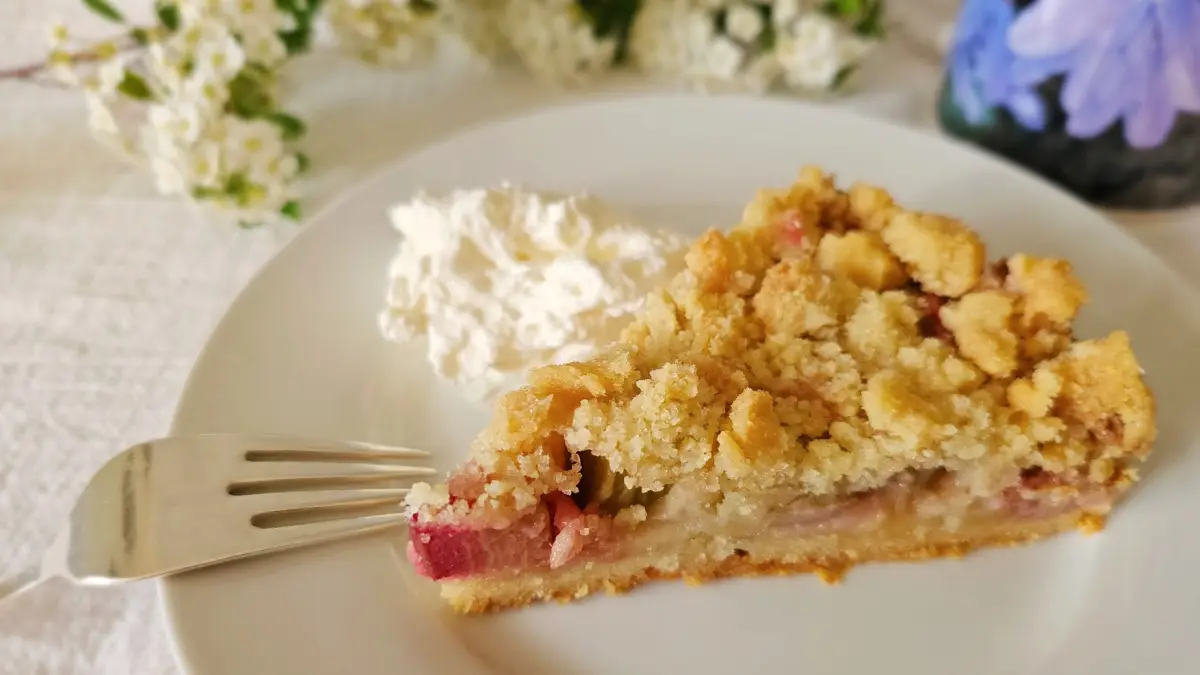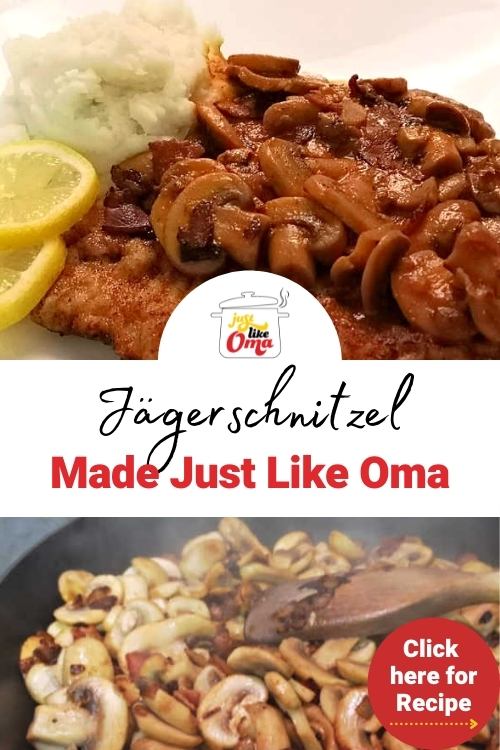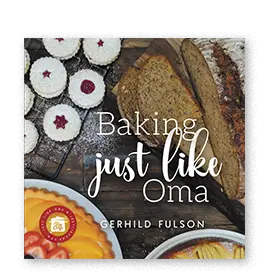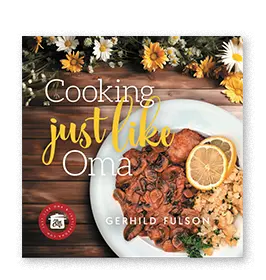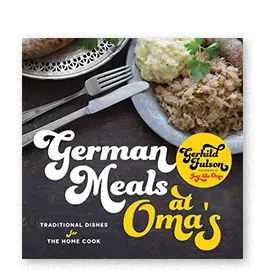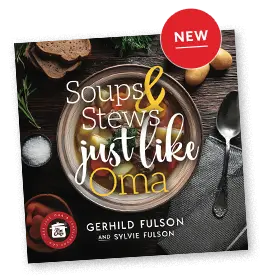Spice up your inbox with FREE German recipes and a free recipe ebook!
Spice up your inbox with FREE German recipes and a free recipe ebook!
- Home
- Traditional German Meat Dishes
- Jägerschnitzel Recipe
Oma's Hunter's Mushroom Gravy (Jägerschnitzel Sosse)

by: Gerhild Fulson / Oma Gerhild shares easy, authentic German recipes you can trust, rooted in family tradition and featured in her cookbooks.
Published: August 8, 2020, Updated: April 20, 2025
This Jägerschnitzel (Hunter’s Schnitzel) is a traditional German dish featuring crispy breaded pork cutlets topped with a rich, creamy mushroom gravy. It's a comforting, hearty meal that brings the taste of German home cooking to your table.
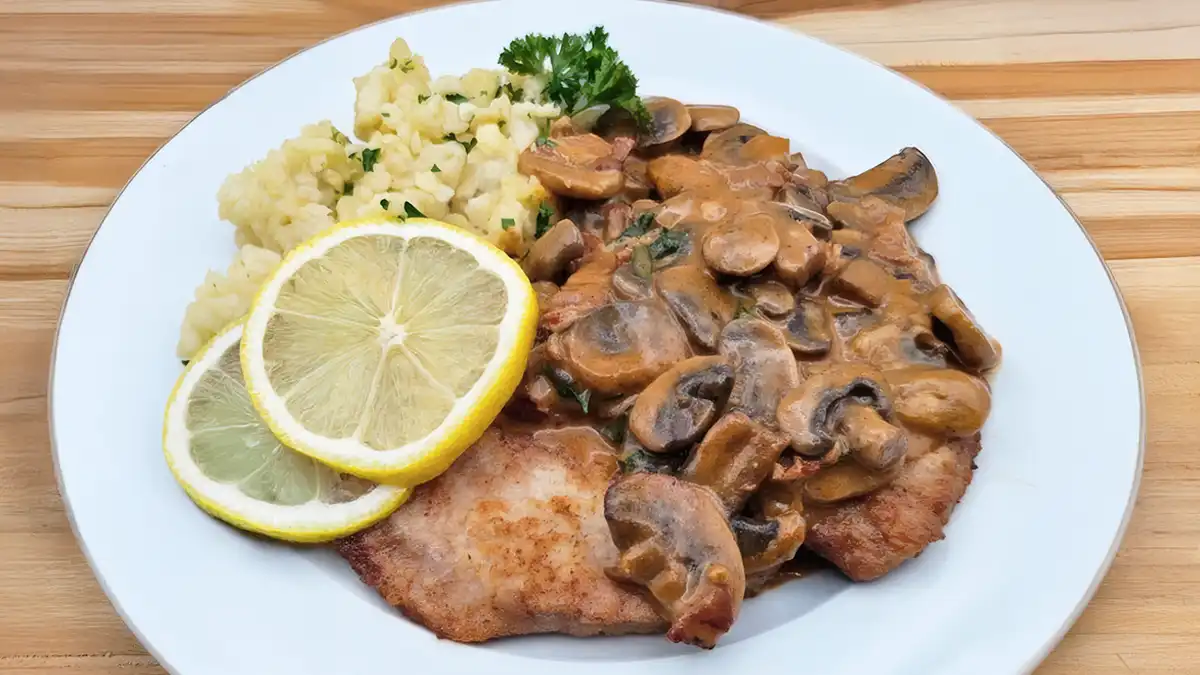 Jägerschnitzel: Pork Schnitzel with mushroom sauce and served with homemade spätzle. Mega lecker!
Jägerschnitzel: Pork Schnitzel with mushroom sauce and served with homemade spätzle. Mega lecker!Whether you write this Jagerschnitzel or the proper German way, Jägerschnitzel or Jaegerschnitzel, it's that heavenly combination of a rich creamy bacon & mushroom gravy over pork schnitzel (cutlets).
Then again, traditional and authentic in a German sense means that there are all sorts of variations. Some love to serve this amazing mushroom sauce over plain schnitzel, meaning that they haven't been breaded, as shown above.
Oma's Recipe Rundown
- Ease of Making: Intermediate; needs basic cooking skills..
- Taste: A blend of savory, earthy, and creamy flavors.
- Time: The sauce takes about 20 minutes from prep to plate.
- Gluten-Free: Yes, but check that your cornstarch is gluten-free
- Best Served With: schnitzel, and spätzle, mashed potatoes, or buttery noodles to soak up every drop of sauce.
Top Tips For Best Results
- Mushroom Selection: While button mushrooms are traditional, incorporating a mix of mushrooms like cremini, porcini, or chanterelles can enhance the sauce's depth of flavor.
- Deglaze the Pan Properly: After cooking the mushrooms and onions, use beef broth (or a splash of red wine) to lift flavorful bits from the bottom of the pan.
- Thicken Gradually: If needed, mix cornstarch with cold water before adding to the sauce. This prevents clumping and ensures a smooth texture.
Some insist that the traditional jäger gravy (Hunter's sauce) has to be made with wine. Some insist on red wine. Others only use white wine.
Others absolutely don't want the bacon. Some insist on Pfifferlinge or Chanterelles for the mushrooms. Others use a mixture of different mushrooms or just plain button ones.
Even with all these variations, this is German food at its finest. A traditional German meal that's PERFECT anytime.
Oma Says
I usually make my Jägerschnitzel the way my Mutti made it. Traditional in our family. Her recipe included breaded pork cutlets, pounded thin, and covered in a mouthwatering sauce that had a bit of a spicy taste, a touch of paprika, and bacon. So wunderbar!
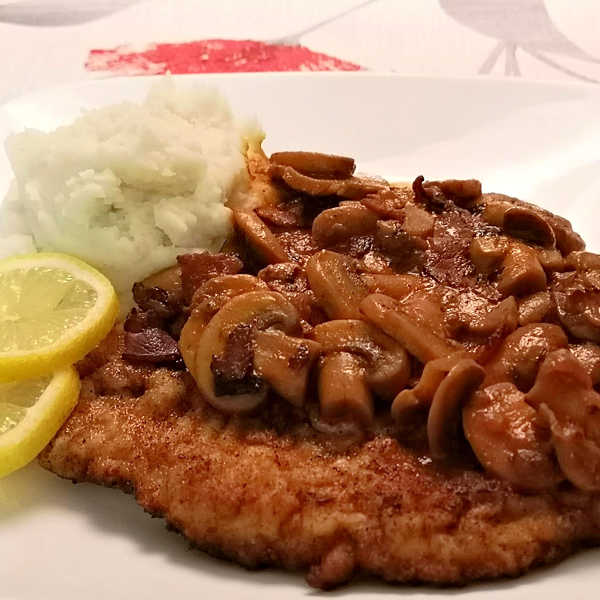 These schnitzel have been breaded (our favorite way of having them)and then served with a wonderful Jäger sauce, a mushroom sauce that's so traditional.
These schnitzel have been breaded (our favorite way of having them)and then served with a wonderful Jäger sauce, a mushroom sauce that's so traditional.Definition of TRADITION:
- Handed down from age to age
- Something that is in keeping with long-standing tradition, style or custom meaning, just the way my (your) Mutti and my (your) Oma did it.
Literally, that means that there are so many traditional recipes for Jagerschnitzel, all that are authentic German recipes, you can choose just the one that matches your taste buds.
How To Make Jäger Sauce
(Find the printable recipe with measurements in the recipe card below.)
Gather your ingredients and get all the chopping and measuring done. Decide what liquid you're going to use. Broth works wonderfully. Wine is great too. Choose your favorite.
For the bacon, if you have access to a really good German bacon, please do use it. If not, just the regular breakfast bacon works as well. That's what I've done here.
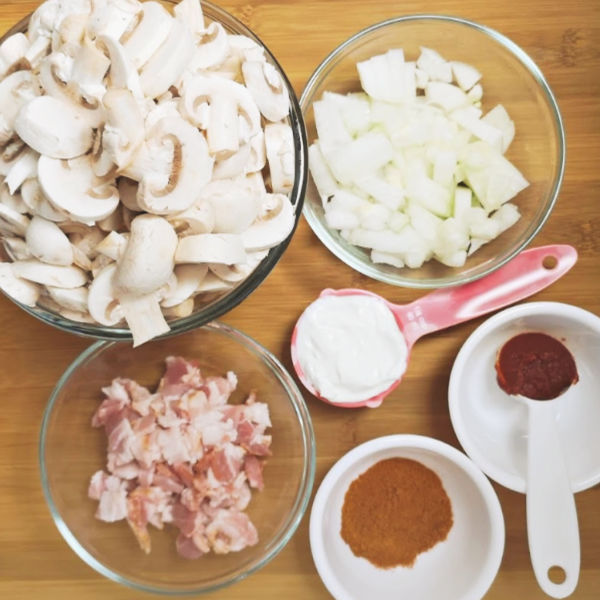 My Jägersosse ingredients include bacon and mushrooms, giving it a delicious flavor
My Jägersosse ingredients include bacon and mushrooms, giving it a delicious flavorWhen you are frying the onion and bacon, do this over a medium heat. You want to render the bacon fat and you want the onions to be translucent.
My onions got a touch golden and that's OK.
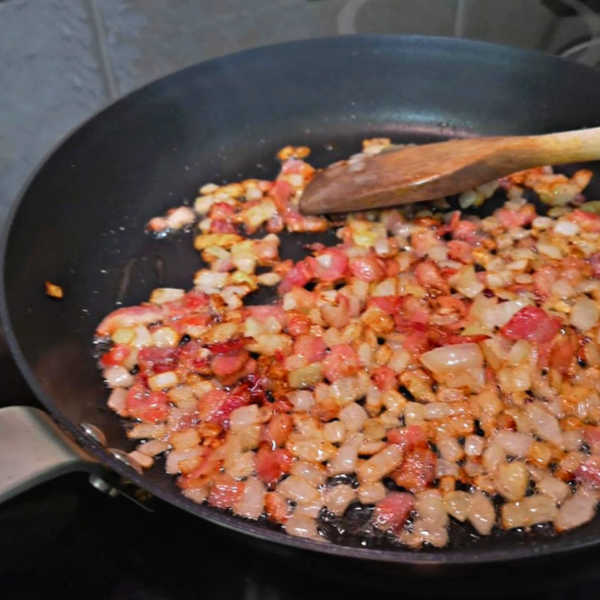 Frying bacon and onions to make jagerschnitzel! Try making this just like Oma!
Frying bacon and onions to make jagerschnitzel! Try making this just like Oma!Stir in your sliced mushrooms. I've used common button mushrooms, but you can choose your favorite variety.
I stir this continually, since I don't want those onions remaining at the bottom of the pan to get too dark.
The mushrooms will give off liquid as they cook, they will shrink in size, and they will get nice and tender. Keep cooking until they look like this:
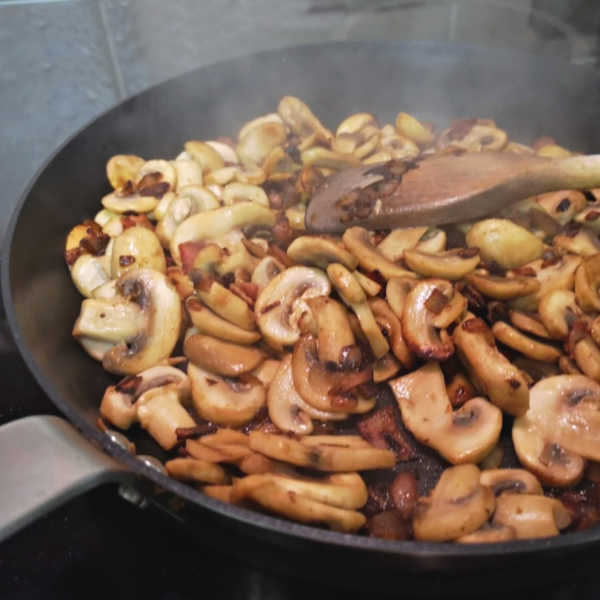 Once the mushrooms are cooked, they're ready for the tomato paste and liquid to be added.
Once the mushrooms are cooked, they're ready for the tomato paste and liquid to be added.Once the mushrooms are a nice brown color, add the tomato paste, your liquid, paprika, and salt and pepper to taste. The amount of seasonings to add will depend on your liquid.
If the broth is already seasoned, you'll need to add just a touch. Stir to mix and let it come to a simmer.
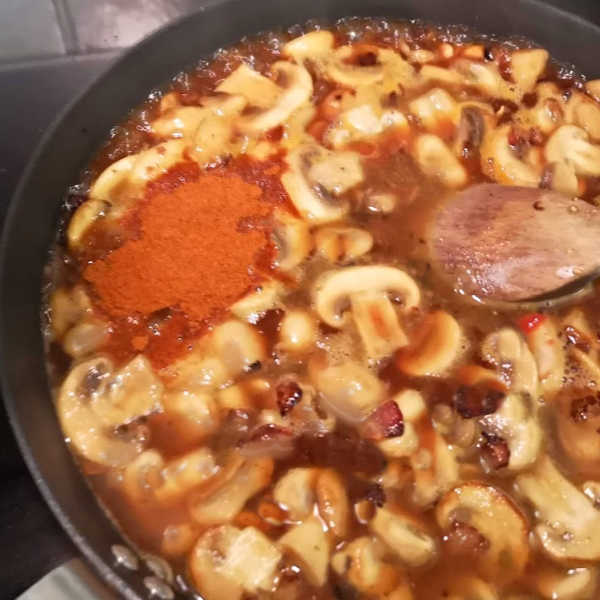 Time to simmer the mushroom sauce. Try making this gravy just like this Oma!
Time to simmer the mushroom sauce. Try making this gravy just like this Oma!Once the simmering has reduced the gravy and it's actually a bit creamy, add your sour cream, stir, and re-season. If the gravy is still too liquid, you can thicken it with a bit of a cornstarch slurry.
Done! If you need to keep this warm, while you wait to fry up your schnitzel, just cover and let it sit on the lowest setting on your stove, as long as it doesn't actually come to a simmer.
If your stove doesn't have a low enough setting, just let it sit on the turned off burner. When you are ready to serve, let it come to simmer briefly to reheat.
Above, I've served the delicious mushroom sauce over breaded pork schnitzel with a side of mashed potatoes. Nothing else needed. Heaven!
OR, serve it over un-breaded schnitzel, whether veal, chicken, turkey, or pork. It's absolutely mega lecker!
Oma's Hunter’s Mushroom Gravy (Jägerschnitzel Sosse)
Jägersoße, or Hunter’s sauce, is a rich, savory mushroom gravy that’s perfect over schnitzel. Some use red wine, others white, or just broth—you decide what’s best!
Prep Time:
5 minutes
Cook Time:
15 minutes
Total Time:
20 minutes
Servings:
4 servings
Ingredients:
- 2 tablespoons butter
- 3 slices bacon, diced
- 1 onion, diced
- 1 pound fresh mushrooms, sliced
- 1 tablespoon tomato paste
- 2 cups beef broth or beef stock
- 1 tablespoon paprika
- salt and black pepper, to taste
- 2 tablespoons fresh parsley, chopped
- 2 tablespoons cornstarch in 2 tablespoons cold water (if needed)
- ¼ cup sour cream, heavy cream, or Greek yogurt
Instructions:
- In a skillet over medium-high heat, cook bacon and onion in butter until the onions are translucent and the bacon has rendered its fat.
- Stir in the sliced mushrooms and cook until tender, about 5 minutes, stirring constantly.
- Mix in the tomato paste and the broth.
- Stir in the paprika. Season with the salt and pepper.
- Bring to boil, reduce heat and simmer gently for about 5 minutes until the gravy thickens slightly. If the sauce is too liquid, slowly add just enough of the cornstarch/water mixture until the desired consistency is reached.
- Stir in the parsley and the sour cream. Season with additional salt and pepper, if necessary.
Notes/Hints:
- Instead of 2 cups of beef broth, use 1 cup water and 1 cup white wine
- Season with thyme
- Serve over plain schnitzel which are just fried in a butter/oil mix.
- Or, do them the way I like them with breaded schnitzel to turn them into Jägerschnitzel.
- This deliciously creamy sauce is also yummy served with breaded pork chops.
* * * * *
Unless otherwise noted recipe, images and content © Just like Oma | www.quick-german-recipes.com
Recipe Update: April 20, 2025
Comments? Questions?
You can leave a comment about this recipe or ask a question...
Pop right over to my private Facebook group, the Kaffeeklatschers. You'll find thousands of German foodies, all eager to help and to talk about all things German, especially these yummy foods.
Meet with us around Oma's virtual table, pull up a chair, grab a coffee and a piece of Apfelstrudel, and enjoy the visit.
Recent Articles
-
Pears, Beans, and Bacon: Birnen, Bohnen, und Speck (from Bremen)
Jul 06, 25 10:47 AM
Pears, beans, and bacon combine to bring the traditional taste of Bremen in Birnen, Bohnen und Speck. Perfect fusion of sweet pears, savory beans & smokey bacon. -
Oma's German Rhubarb Crumb Cake (Rhabarberkuchen mit Streusel)
Jul 02, 25 11:28 AM
This German Rhubarb Cake (Rhabarberkuchen mit Streusel) tastes just like Mutti’s … sweet, tart, buttery, and baked with love. -
Oma's Pineapple Icebox Cake (Ananas-Kühlschrank Dessert)
Jul 02, 25 10:18 AM
This no-bake ice box cake, ananas-kühlschrank dessert is creamy and ratze fatze easy ... a favorite summer treat made right in the serving dish.
Words to the Wise
"The words of the godly are a life-giving fountain; the words of the wicked conceal violent intentions."
Proverbs 10:11 (NLT)


